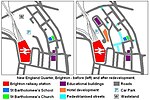Brighton Forum

Citibase Brighton (previously known as The Brighton Forum by Topcentre) is a complex of serviced offices on a prominent elevated position in the Round Hill area of Brighton, part of the English city of Brighton and Hove. The large Gothic Revival building, by two architect brothers from London, has had three greatly different uses since its construction at the edge of Brighton parish in 1854: for its first 85 years, it trained Anglican schoolmistresses; then it became a military base and records office; and in 1988 it opened as a multipurpose business centre and office complex. The elaborate flint exterior is finely detailed in the Gothic style, especially around the windows. English Heritage has listed it at Grade II for its architectural and historical importance.
Excerpt from the Wikipedia article Brighton Forum (License: CC BY-SA 3.0, Authors, Images).Brighton Forum
Ditchling Road, Brighton Round Hill
Geographical coordinates (GPS) Address External links Nearby Places Show on map
Geographical coordinates (GPS)
| Latitude | Longitude |
|---|---|
| N 50.8332 ° | E -0.1345 ° |
Address
Citibase Brighton
Ditchling Road 95
BN1 4ST Brighton, Round Hill
England, United Kingdom
Open on Google Maps









